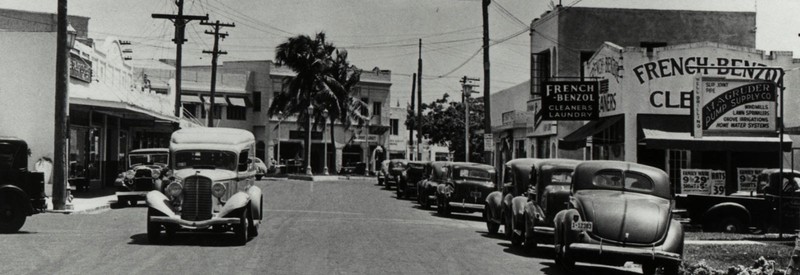Coconut Grove
Introduction
Text-to-speech Audio
Images
Historic Coconut Grove Photo source: http://www.coconutgrove.com/history/

Backstory and Context
Text-to-speech Audio
Edmund and Ann Beasley are cited as the Grove’s first permanent settlers; after Ann was widowed she rented out some of the Beasley property to a Dr. Horace Porter, who attempted to establish a U.S. Post Office in the area, naming it Coconut Grove after observing the Coconut Palms that were nearby. However, Dr. Porter not being successful at his attempt, moved away and the post office was forgotten. Other prominent 19th century settlers were the Bahamas-native Pent and Frow families, brothers “Jolly” Jack and Charles Peacock and their family, and sailboat designer Ralph Munroe. The Peacock brothers and Monroe forged a friendship and together opened the area’s first hotel, the Bay View Inn, in 1882. In reviewing a postal map, Munroe also discovered Dr. Porter’s post office, and he and his comrades reopened it, re-establishing the community’s name Coconut Grove. The sub-tropical community attracted an increasing number of visitors and the hotel entrepreneurs expanded the building in order to host more guests; they also changed the hotel’s name to the Peacock Inn.
During WWI, one of the United States’ first naval air stations was built on a nearby island, Dinner Key. Over 1,000 men were trained there, and Coconut Grove citizens voiced their annoyance with the noise and pollution that resulted from the base. The government closed the station in 1919, the same year Coconut Grove became an incorporated town. However, the Grove’s township only lasted six years before it was annexed by the City of Miami. Eventually, in 1929, the old Navy air station became a hub for Pan American Airways.
All through the twentieth century, the Grove flourished as a cultural center, attracting “creative types like the writers Marjory Stoneman Douglas, Hervey Allen, and Tennesse Williams, as well as many of the areas most accomplished artists and musicians.” The Grove’s Bohemian atmosphere has also drawn “beatniks and hippies” and even today hosts eccentric crowds.
